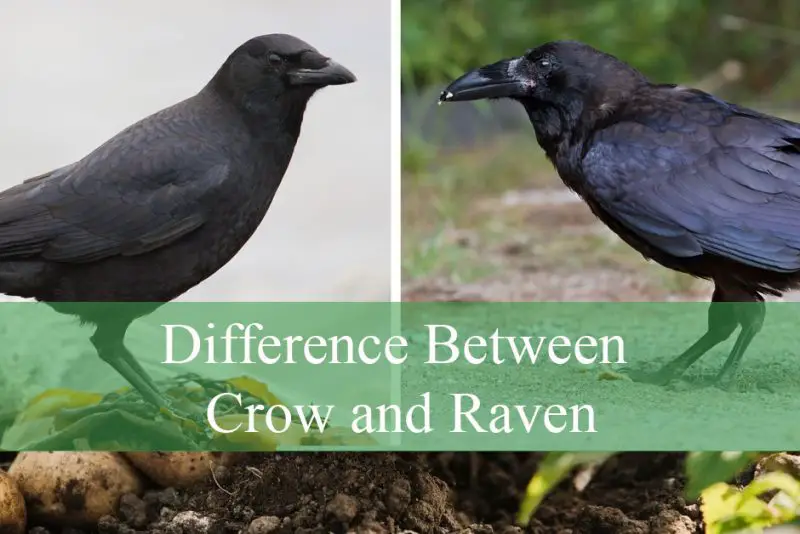Crows and ravens have captivated the human imagination for centuries. These intelligent black birds appear in folklore, literature, and even spiritual traditions across cultures. But despite their familiarity, most people still struggle to tell the difference between a crow and a raven. Both belong to the genus Corvus, both are entirely black, and both are known for their sharp minds and complex behaviors. Yet when observed closely, there are several key features and behavioral traits that set them apart.
Understanding the difference between crow and raven isn’t just about birdwatching accuracy. It opens up a window into the fascinating world of corvids and reveals how nature can craft variations even within a shared family tree. In this article, we’ll explore the most telling distinctions between these two species—from physical characteristics and vocalizations to habitats and social structures.
Exploring the Genus Corvus

The scientific classification of both birds falls under the Corvus genus, which includes over 40 different species of crows, ravens, rooks, and jackdaws. Despite their close relationship, ravens and crows are distinct species with separate evolutionary paths. The most commonly compared species are the American crow (Corvus brachyrhynchos) and the common raven (Corvus corax), particularly because they both inhabit wide regions across North America and often overlap in range.
Their similarities make confusion understandable. Both have glossy black feathers, strong beaks, and similar silhouettes when seen from a distance. They’re also among the most intelligent birds in the world, capable of using tools, solving puzzles, and demonstrating remarkable memory. However, these birds serve different roles in their ecosystems and display unique behaviors that help define their identities.
Size and Body Structure as Primary Indicators
One of the most immediate and reliable ways to distinguish between a crow and a raven is by examining their size and body shape. Ravens are significantly larger than crows. A raven typically has a body length approaching twenty-seven inches with a wingspan exceeding four feet. In contrast, the average crow is smaller, measuring about seventeen inches in length and sporting a wingspan closer to three feet.
In addition to size, their body proportions offer important clues. Ravens have heavier, more powerful builds, with thicker necks and broader chests. Their bills are also more prominent—thicker and more curved than the crow’s more slender, straighter beak. A closer look at the feathers around their throats also reveals a distinctive difference: ravens have shaggy throat feathers known as hackles, which often stand out during vocalization or display behaviors.
These physical differences become clearer when the birds are seen side by side, though this isn’t always possible in the wild. Even when viewed separately, a bird’s general bulkiness, head shape, and beak structure can point toward one identity over the other. Birdwatchers often rely on these characteristics when making field identifications.
Flight Patterns and Aerial Behavior
The way a bird moves through the air can also provide strong clues to its identity. Crows tend to flap their wings rapidly and steadily, which gives them a more consistent and predictable flight. They don’t often soar or glide for long periods. Their flight pattern is purposeful, with wingbeats that are fast and frequent.
Ravens, on the other hand, are known for their acrobatic and effortless flying styles. They soar more frequently, using thermal currents to glide long distances with minimal flapping. Their wingbeats are deeper and slower, and they often perform aerial rolls, dives, and complex maneuvers that demonstrate agility and control. These characteristics make them resemble birds of prey in flight, such as hawks or eagles.
Their tail shape is another helpful identifier during flight. When seen from below, a crow’s tail spreads out like a fan, with all feathers about the same length. A raven’s tail, by contrast, forms a wedge shape with longer central feathers. These tail structures are particularly noticeable when the birds are banking or coming in for a landing.
Vocal Differences and Communication
One of the most fascinating differences between crows and ravens lies in their vocalizations. While both are known for their loud, harsh calls, the quality and range of their sounds differ substantially. Crows produce a signature “caw” sound that is sharp and repetitive. These calls are used in a wide variety of social interactions, from territory defense to group coordination.
Ravens, in contrast, have a much deeper and more resonant call that often resembles a low, croaking “kraaa.” Their vocal range is broader and includes gurgles, rattles, and even imitative sounds. Ravens are known to mimic other animals and environmental noises, a behavior that underscores their intelligence and adaptability.
These vocal differences can be heard even from a distance and are often one of the first clues to a bird’s identity. The tone, pitch, and rhythm of their calls provide insight into not only which species you’re hearing but also what they might be communicating. Ravens often call in pairs or as solitary individuals, whereas crows are more likely to be heard calling as part of a group.
Social Behavior and Group Dynamics
Crows and ravens also exhibit different social structures. Crows are highly social birds, often seen gathering in large groups for roosting, feeding, or mobbing predators. These groups, sometimes numbering in the hundreds or even thousands, demonstrate a strong communal instinct. They work together to protect one another, share information, and raise young in cooperative settings.
Ravens, on the other hand, are more solitary or found in pairs. While they do form temporary flocks during winter or migration, they don’t maintain the large, long-term group bonds that crows do. Mated pairs of ravens often remain together for life, displaying strong territorial behavior and nesting far away from other ravens.
This difference in group behavior affects how the birds interact with humans and other animals. Crows are more comfortable in urban and suburban settings, where they take advantage of human infrastructure, garbage, and agriculture. Ravens are more reclusive and tend to avoid densely populated areas, preferring remote forests, cliffs, and mountainous terrain.
Nesting Habits and Breeding Preferences
Both crows and ravens are dedicated parents, but their nesting behaviors reveal key distinctions. Crows typically build nests in trees, often at moderate heights, and usually close to human activity. Their nests are made of twigs, leaves, and softer materials for lining. They may reuse nests in consecutive years or build new ones nearby.
Ravens choose more secluded nesting sites. They often build their nests on high cliffs, rocky outcrops, or tall trees in wilderness areas. Their nests are larger and more rugged in construction, often made with larger sticks and fortified against the elements. These locations reflect their preference for privacy and distance from potential disturbances.
The number of eggs laid and the timeline for raising chicks also varies slightly between the species. Crows typically lay between three and six eggs, while ravens usually produce between two and five. In both cases, the chicks are altricial—born helpless and reliant on parental care. The parents feed and protect the young for several weeks before fledging.
Habitat Preferences and Geographic Distribution
Although both birds are widely distributed, they occupy different ecological niches. Crows are generalists and have adapted well to human-altered landscapes. They thrive in farmlands, cities, suburbs, and open fields. Their intelligence and flexibility allow them to exploit a wide range of food sources, from carrion and insects to fruits and human leftovers.
Ravens, while also omnivorous, prefer wilder environments. They are commonly found in mountainous regions, deep forests, tundra, and deserts. Their avoidance of crowded human areas sets them apart from crows, who are commonly seen perching on telephone wires, digging through trash, or walking across parking lots.
Despite these differences, their territories do sometimes overlap, especially in transitional zones where wild land meets human development. In these areas, interactions between the two species can occur, and competition for food or nesting sites may arise. However, each species tends to maintain its ecological role and space when possible.
Intelligence and Problem-Solving Abilities
Both crows and ravens are known for their cognitive skills, which rival those of some primates. They can recognize human faces, use tools, plan for future events, and engage in complex problem-solving. However, studies suggest that ravens may exhibit even more advanced cognitive behaviors, particularly in social intelligence and communication.
Ravens have been observed manipulating other animals to achieve a goal, such as distracting a predator to gain access to a carcass. They can also hide food from others and remember where they stored it days or even weeks later. These behaviors indicate a high level of memory and strategic thinking.
Crows also demonstrate impressive intelligence. Urban crows in Japan have been seen using traffic lights to crack nuts—placing them on the road and waiting for cars to run over them. In research settings, crows have solved multi-step puzzles, showing an understanding of cause and effect, patience, and tool use.
These mental abilities contribute to their survival in diverse environments. Intelligence allows both species to adapt to changes, avoid dangers, and exploit opportunities. Their problem-solving skills make them fascinating subjects of research and icons of avian intelligence.
Symbolism and Cultural Representation
Throughout history, crows and ravens have held symbolic significance in myths, legends, and spiritual beliefs. While they are often associated with darkness or death, they also represent wisdom, transformation, and prophecy. In Norse mythology, Odin’s two ravens, Huginn and Muninn, flew around the world gathering knowledge. Native American cultures often viewed the raven as a trickster or a creator figure.
Crows appear frequently in folklore as messengers or omens. In some traditions, they are associated with ancestors or the afterlife, while in others they represent cleverness and adaptability. Their constant presence near human settlements has made them familiar figures in stories and superstitions.
Despite these associations, scientific research paints a more nuanced picture. These birds are neither good nor evil—they are highly evolved animals with behaviors shaped by their environment and biology. Understanding the differences between crows and ravens helps us move beyond stereotypes and appreciate their true nature.
Final Thoughts on Identification
While many of their differences may seem subtle, a careful observer can begin to separate crow from raven with confidence. Paying attention to size, beak shape, flight patterns, calls, and social behavior can offer clear insights. With time, even the casual birdwatcher can learn to distinguish between these two remarkable birds.
Recognizing these distinctions deepens our understanding of avian diversity and highlights the complexity of the natural world. Crows and ravens, though similar at first glance, represent two unique paths in the evolution of birds. Their shared ancestry and divergent traits make them a fascinating case study in adaptation and survival.
FAQ About the Difference Between Crow and Raven
Are crows and ravens the same species?
No, crows and ravens are different species, although they both belong to the Corvus genus.
Which bird is bigger, a crow or a raven?
Ravens are significantly larger than crows, with broader wingspans and more robust bodies.
How can I tell them apart by their call?
Crows produce a sharp “caw” sound, while ravens have a deeper, croaking call that sounds more like “kraaa.”
Where do ravens live compared to crows?
Ravens prefer remote wilderness areas, while crows are more common in urban and suburban environments.
Do crows and ravens interact with humans differently?
Yes, crows are more comfortable around people and often live near human activity, while ravens tend to be more wary and reclusive.






